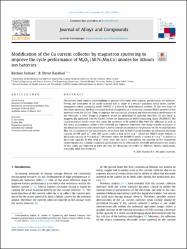| dc.contributor.author | Solmaz, Ramazan | |
| dc.contributor.author | Karahan, Billur Deniz | |
| dc.date.accessioned | 2021-04-09T07:51:38Z | |
| dc.date.available | 2021-04-09T07:51:38Z | |
| dc.date.issued | 2021 | en_US |
| dc.identifier.citation | Solmaz, R. ve Karahan, B. D. (2021). Modification of the Cu current collector by magnetron sputtering to improve the cycle performance of MxOy (M:Ni,Mn,Co) anodes for lithium ion batteries. Journal of Alloys and Compounds, 872. https://dx.doi.org/10.1016/j.jallcom.2021.159594 | en_US |
| dc.identifier.issn | 0925-8388 | |
| dc.identifier.issn | 1873-4669 | |
| dc.identifier.uri | https://dx.doi.org/10.1016/j.jallcom.2021.159594 | |
| dc.identifier.uri | https://hdl.handle.net/20.500.12511/6717 | |
| dc.description.abstract | The present work reports a methodology to produce electrodes with superior performances for batteries. Herein, the fabrication of an anode material that is made of a ternary transition metal oxides (nickel-manganese-cobalt containing oxide, NMCO) is achieved by hydrothermal method. Of the two kinds of electrodes prepared, the first is realized by direct lamination of a slurry that contains NMCO powders active materials onto the Cu foil. Then, to improve the mechanical, physical and electrochemical performance of the electrode, a novel design is proposed, where an additional Ni underlay thin film (10 nm thick) is magnetically sputtered onto the Cu foil, before the lamination of NMCO containing slurry (Ni/NMCO). The characterization results show that upon the existence of Ni underlay film both the adhesion as well as the stress accomodation ability of the electrode are improved. Moreover, the charge transfer resistance at the electrode/current collector interface is noted to be decreased due to the presence of the Ni underlay thin film. As a consequence, the galvanostatic tests show that Ni/NMCO anode exhibits an enhanced discharge capacity of 845 mAh g−1 after 200 cycles under a load of 0.1 A g−1, whilst the NMCO anode delivers a discharge capacity of 442 mAh g−1. Moreover, when the Ni/NMCO anode is cycled at 1 A g−1, it delivers a discharge capacity of 844 mAh g−1 even after 100 cycles. Considering the position of the magnetron sputtering process in today's industrial applications and its effect on the electrode performance, the results of this study are expected to pave the way for designing electrodes of different battery applications, especially solid state batteries. | en_US |
| dc.description.sponsorship | International Technological University | en_US |
| dc.language.iso | eng | en_US |
| dc.publisher | Elsevier Ltd | en_US |
| dc.rights | info:eu-repo/semantics/embargoedAccess | en_US |
| dc.subject | Hydrothermal Method | en_US |
| dc.subject | Li Ion Battery | en_US |
| dc.subject | Magnetron Sputtering | en_US |
| dc.subject | Ni Thin Film | en_US |
| dc.subject | Transition Metal Oxide Anodes | en_US |
| dc.title | Modification of the Cu current collector by magnetron sputtering to improve the cycle performance of MxOy (M:Ni,Mn,Co) anodes for lithium ion batteries | en_US |
| dc.type | article | en_US |
| dc.relation.ispartof | Journal of Alloys and Compounds | en_US |
| dc.department | İstanbul Medipol Üniversitesi, Mühendislik ve Doğa Bilimleri Fakültesi, İnşaat Mühendisliği Bölümü | en_US |
| dc.department | İstanbul Medipol Üniversitesi, Rektörlük, Sağlık Bilim ve Teknolojileri Araştırma Enstitüsü | en_US |
| dc.identifier.volume | 872 | en_US |
| dc.relation.publicationcategory | Makale - Uluslararası Hakemli Dergi - Kurum Öğretim Elemanı | en_US |
| dc.identifier.doi | 10.1016/j.jallcom.2021.159594 | en_US |
| dc.identifier.wosquality | Q1 | en_US |
| dc.identifier.scopusquality | Q1 | en_US |


















